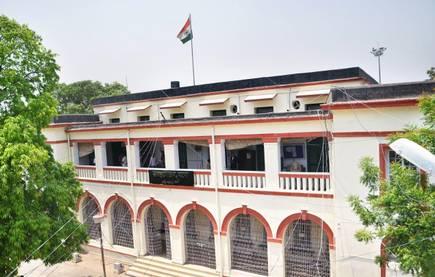Historians, Architects, Heritage Lovers Hail SC Stay on Patna Collectorate Demolition

Patna Collectorate. | Image Courtesy: The Hindu
New Delhi/Patna: Historians, conservation architects and other heritage lovers have heaved a sigh of relief and expressed happiness over the stay by the Supreme Court on the demolition of the centuries-old Patna Collectorate, with some saying it would send a "strong message" to the society on "preserving our rich past indiscriminately".
Spread over 12 acres on the banks of Ganga, the iconic collectorate complex includes one of the last surviving signatures of Dutch architecture, especially the Record Room and the old District Engineer's Office.
The top court had on Friday ordered status quo in the case, two days after Bihar Chief Minister Nitish Kumar had laid the foundation stone for its new complex and a slew of other projects ahead of the Assembly polls.
Noted historian Irfan Habib said it is "great news for all those who care for built heritage, from conservationists to common man, fighting a battle every day to save heritage from the onslaught of modernity".
"The stay on demolition, at a time when bulldozers were almost ready to roll in to bring down the historic structures of the collectorate, will also reaffirm people's faith in judiciary when heritage is facing a losing battle in Patna and so many other old cities," he said.
The historian underlined that old buildings, especially of such significance as the Patna Collectorate, "lend character to a city" and the Bihar capital, being a historic city, these landmarks give a "sense of continuity to multiple generations".
"Erasing these landmarks will not only erase an important piece of history of Patna, it will erase the identity of the city of Patna," he said. "The government should preserve and restore these buildings indiscriminately and not look at them through a colonial prism."
Patna-based author Surendra Gopal who has been advocating preservation of the collectorate and other unprotected landmarks, hoped "a brighter future awaits" the neglected built heritage of his city.
The case, which began with two PILs filed in the Patna High Court by Indian National Trust for Art and Cultural Heritage (INTACH) in August 2019, had rallied heritage lovers from Patna to the US, with domain experts and common people alike appealing to the authorities to spare the demolition and instead connect it to the tourism circuit.
On September 1 this year, the high court disposed the case and allowed the government to take "necessary consequential action" after the newly-formed Bihar Urban Arts and Heritage Commission -- consisting only of government officials -- recommended demolition, claiming the structure had not much "architectural, cultural or aesthetic values".
The Bihar government, which proposed the demolition in 2016, has been claiming that since the Dutch building of the collectorate was used as a warehouse to store opium and saltpetre a few centuries ago, it was "not a heritage structure", drawing sharp reaction from historians, scholars and experts.
Architect and conservationist Yashaswini Sharma, who has been associated with the battle to save the iconic Asiatic Building in Bengaluru, was thrilled to know about the apex court stay after the INTACH filed a plea mid-September challenging the high court order.
"A building's heritage value is not lessened just because it was an opium warehouse at some point in history," Sharma said. "It is the unique architecture, material heritage, the skills used in making the building that matters. And these were built by our labourers, making it even a more significant piece of heritage."
The author of 'Bangalore: The Early City' said to dismiss a building as "not a heritage" just because it stored opium once, was "myopic and smacks of ignorance and coloured view of the policy makers".
The high court should have weighed in the matter with deeper understanding of history and architectural heritage, which it seems it did not, so the INTACH appealed in the Supreme Court," she added.
In 2016, the then Dutch ambassador, Alphonsus Stoelinga, had written to the chief minister, appealing to preserve this "shared heritage" of the two countries and had it listed under the Archaeology Department.
The British-era structures in its complex include the DM Office Building and District Board Patna Building.
In 2016, a public movement named 'Save Historic Patna Collectorate', led by citizens from various walks of life, was launched to save the historic landmark from demolition.
Mumbai-based conservationist Kamalika Bose said the apex court relief was "much-needed and it would send a very strong message to both the government and the society at large to "preserve our past indiscriminately for the current and future generations".
"Bihar government has not been listening to people's voices, and I hope now they will and save this landmark. The new collectorate can be built anywhere else on a fresh piece of land without harming heritage," she said.
The Supreme Court bench, headed by Chief Justice S A Bobde, has sought response from the Bihar government within two weeks on the plea filed by the INTACH.
High court lawyer and heritage activist Kumar Shanu alleged that "in the name of opium warehouse, the government has attempted to delegitimise the historical value of the collectorate".
"The Hon'ble High Court of Patna has not acknowledged or even heeded to the complete facts of the case and principles developed by previous landmark cases on such a subject," he argued, adding: "I am happy the apex court has given a relief for the time being".
Get the latest reports & analysis with people's perspective on Protests, movements & deep analytical videos, discussions of the current affairs in your Telegram app. Subscribe to NewsClick's Telegram channel & get Real-Time updates on stories, as they get published on our website.
























